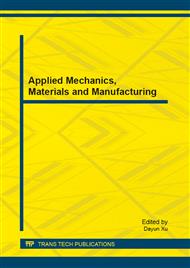p.418
p.424
p.429
p.435
p.440
p.444
p.449
p.455
p.459
The Color Mixing White-Light LEDs
Abstract:
Thepaperis discussedin coloruniformity study.The experiment divided into two steps in this study,first is modules design and simulation. Second is fabrication and measurement.After measure the LEDs property, calculating the ratio of each colored LEDs by using Grassmanns Law,modeling by Solidworks, and simulating the front study by optical software TracePro.Using four-color mixing with self-developed formula to avoid the present white light emitting diode patent, and the four-color grains are Red, Green, Blue and adding Y to modify the overall quality of the mixed light.The phosphorproduceSteabler-Wronsk hardly in the high temperatureas compared tofour-color mixing.Using four-color mixing to producehigher color rendering index than yellow phosphor.Series-parallel array of grain arrangement adopted to achieve the high demand for uniformity, while simplifying the design conditions by a certain current instead of the general mixed light-driven complex driver circuit,the completion of the mixing module using integrating sphere, light spectrum on the spectrophotometer, optical power, color coordinates values, such as mixing uniformity measurements.The chromaticity coordinates errors after complete results of the mixing module measurement and simulation can be controlled under (0.01x, 0.01y).
Info:
Periodical:
Pages:
440-443
Citation:
Online since:
August 2013
Authors:
Keywords:
Price:
Сopyright:
© 2013 Trans Tech Publications Ltd. All Rights Reserved
Share:
Citation:


